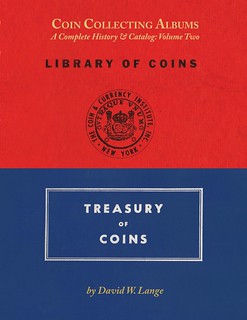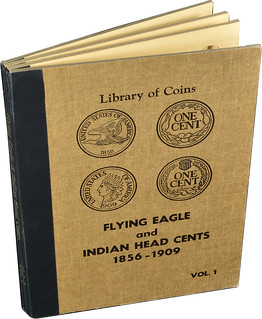
PREV ARTICLE
NEXT ARTICLE
FULL ISSUE
PREV FULL ISSUE
BOOK REVIEW: COIN COLLECTING ALBUMS, VOLUME TWO
Earlier this year David Lange released his newest book, Coin Collecting Albums – A Complete History & Catalog: Volume Two, Library of
Coins and Treasury of Coins. I've finally had a chance to give it a good look, and here are my thoughts. First, here's an
excerpt from the Introduction which sets the stage for this new volume.
If the name Coin and Currency Institute is not immediately recognizable to the reader, its products certainly are widely known. The company continues to operate today, publishing updated editions of its signature titles— Paper Money of the United States, Gold Coins of the World and So-Called Dollars. There was a time, however, when it was just as well known for its extensive line of very popular coin albums that were issued under the banner Library of Coins. Though now long out of print, these coin albums are well remembered by those active in the coin hobby and business during the 1960s. They continue to enjoy good sales on the secondary market, and some coin dealers even feature clean copies of these old albums on their websites. The scarcer and more highly sought titles are apt to bring $100+ in their rare appearances on eBay and other online sales venues. The market for these albums is divided between those seeking them to store coins and those simply desiring to gather them as collectibles in their own right. Sometimes it takes a visionary to plow new fields and lead the way for others. Together with his first volume on coin collecting boards, David has done just that for this subfield of numismatics, the study and collecting of storage and display products for coin collections. While some have scoffed and dismissed the concept out of hand, that's a common reaction to new numismatic books and organizations. Some were dumbfounded when Augustus Heaton published his 1893 book on Mint Marks - why would anyone ever care about the presence or absence of a tiny letter on their coins? Similarly, the first studies on die varieties were dismissed by some as a silly, unnecesary fad. Yet no one in the hobby today would dispute their importance or fail to note a scarce mint mark or variety when selling a coin. I would invite any skeptics to actually read David's books. Within their pages are interesting stories of hobby history and reams of previously unpublished information. Anyone investigating the nature and growth of the numismatic field in the 1950s and 60s would do well to study these books and learn the stories of the remarkable growth that occurred in that era. As noted in the Introduction, this book is primarily a tale of the Capitol Coin Company and their products. Part one addresses the history of the company, the Friedberg family behind it, as well as their Coin and Currency Institute, which endures today. The remaining major parts are detailed catalogs of their Library of Coins and Treasury of Coins product lines. The Capitol Coin Company had its roots in the 1930s. Founded by Robert Friedberg, it became the largest U.S. vendor of collectible coins from the 1950s through the 1970s. Yet it was little known among the general public, because most of its sales were through department stores throughout the country. As a young collector myself growing up in that era, I often visited these coin departments in my hometown of Pittsburgh, PA. Dave had a similar experience growing up in San Francisco. The book details the rise (and eventual demise) of this giant retail empire, which served as a launching point for the coin storage products covered in the book. 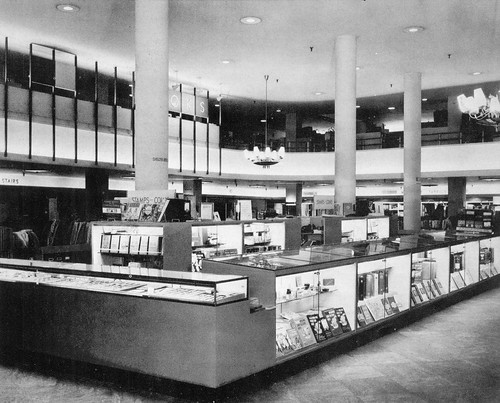 Capitol Coin Company's Coin and Stamp Department at Baltimore's Hutzler's Store, Featuring Library of Coins albums for sale The book covers the history of the company, its struggles during WWII and its connection with the Minkus stamp company which had the direct contracts with the department stores. The stores wanted to give customers the impression that the departments were owned and operated by the stores themselves, so Jacques Minkus and the Friedbergs had to operate in anonymity behind the scenes. Among previously little-known facts discussed in this book are some of the premier rarities in U.S. and world coinage that passed through the Friedberg's hands, including a 1787 Brasher Doubloon and an 1894-S Dime, both purchased over the counter in department store coin shops. The book has interesting background on the market for coin storage products in the 1950s with the Wayte Raymond albums being the most popular. But Robert Friedberg saw that the existing lines of albums were not growing and changing with the hobby, and saw an opening for an improved product and began working on his concept as early as 1956. In 1959 the Library of Coins albums made their public debut. Below is an advertisement from the June 1959 Numismatic Scrapbook Magazine. For bibliophiles, next to it is a 1964 ad for six of the books written or published by Friedberg, many of which are still key references today. 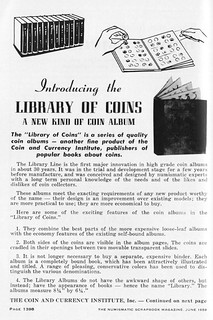 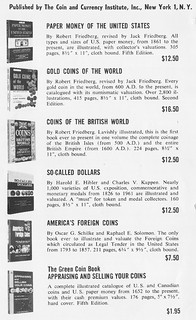
As noted, the bulk of the book is devoted to a catalog of the individual Library of Coins and Treasury of Coins albums. All are given Lange catalog numbers, and notes provide diagnostics for determining the particular edition or variant.
Coin Collecting Albums – A Complete History & Catalog: Volume Two, Library of Coins and Treasury of Coins is available from the author for $49.95. Shipping is $10 for priority mail in a sturdy box. I recommend it to E-Sylum readers and anyone with an interest in the history of our own hobby, especially skeptics who wonder what anyone could learn from studying these peripheral items; read it and you'll see - a lot. For more information, or to order, see:
To visit the Coin & Currency Institute web site, see:
To read the earlier E-Sylum article, see:
Wayne Homren, Editor The Numismatic Bibliomania Society is a non-profit organization promoting numismatic literature. See our web site at coinbooks.org. To submit items for publication in The E-Sylum, write to the Editor at this address: whomren@gmail.com To subscribe go to: https://my.binhost.com/lists/listinfo/esylum All Rights Reserved. NBS Home Page Contact the NBS webmaster 
|
